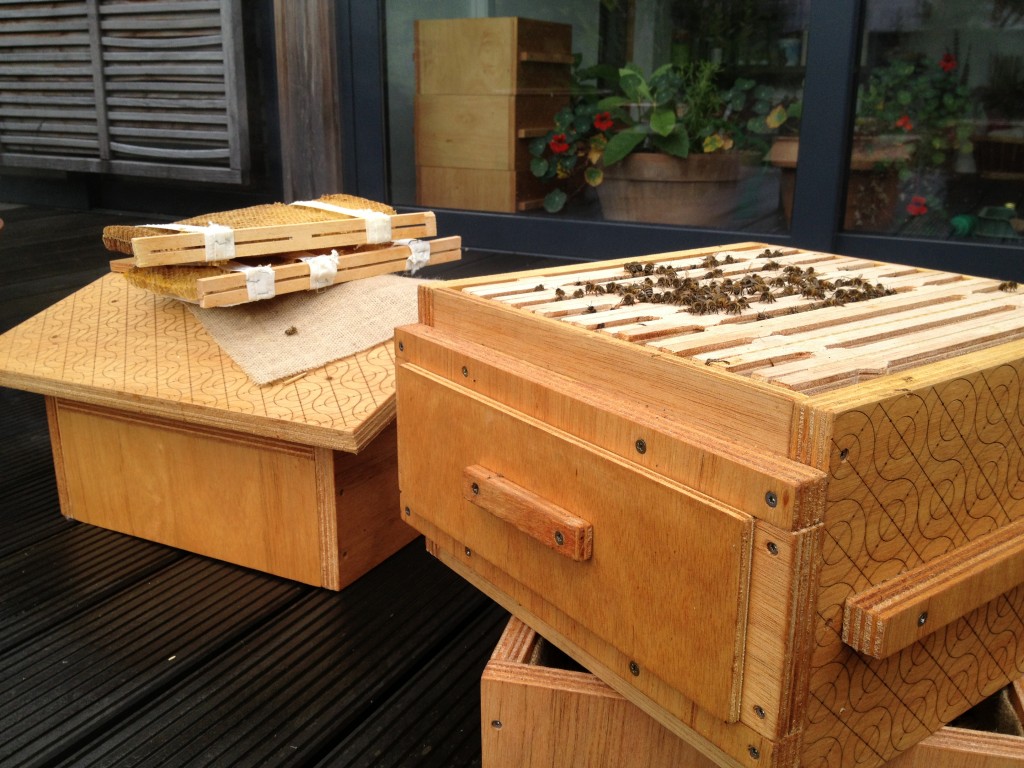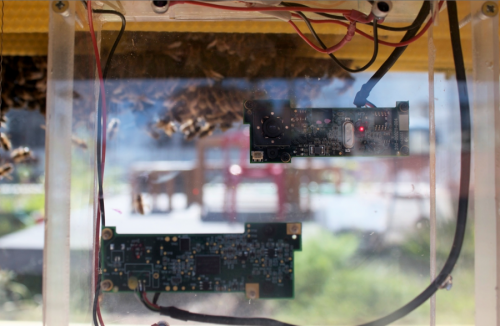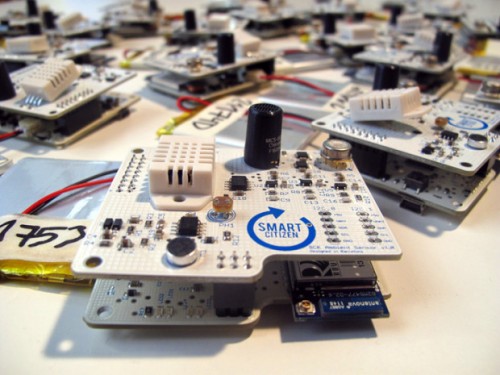- makeITcircular 2024 content launched – Part of Maker Faire Rome 2024Posted 2 weeks ago
- Application For Maker Faire Rome 2024: Deadline June 20thPosted 2 months ago
- Building a 3D Digital Clock with ArduinoPosted 7 months ago
- Creating a controller for Minecraft with realistic body movements using ArduinoPosted 7 months ago
- Snowflake with ArduinoPosted 8 months ago
- Holographic Christmas TreePosted 8 months ago
- Segstick: Build Your Own Self-Balancing Vehicle in Just 2 Days with ArduinoPosted 8 months ago
- ZSWatch: An Open-Source Smartwatch Project Based on the Zephyr Operating SystemPosted 9 months ago
- What is IoT and which devices to usePosted 9 months ago
- Maker Faire Rome Unveils Thrilling “Padel Smash Future” Pavilion for Sports EnthusiastsPosted 10 months ago
Saving Bees in Open Source: Interview to Tristan Copley Smith and Open Source Beehives project
There’s been a lot of talking around the Bee collapse problem and you may be already informed about the topic but, just in case you are not, the excellent information available on this article will help you navigate.
Wanna know the punchline? Well, “Honeybees Are Still Dying and We Still Don’t Know Why” and that’s worrying because as the article explains “bees help pollinate crops that are worth more than $200 billion a year” and feed millions of people.
So when we’ve seen the birth of the Open Source Beehive project, it really sounded great: few Open Source Hardware and Open Source Electronics enthusiasts put together a clear vision and an easy to join project, by combining open design and citizen science to save bees and well, humanity.
We really think this project can make a huge impact both on Bee Collapse problem and, in general – also thanks to the combination with Smart Citizen, created at FabLab Barcelona – in moving forward citizen powered, open science initiatives.
So when we noticed that the guys were campaigning, we took the chance to share some emails with Tristan Copley Smith, one of the project founders. First, we asked Tristan about the context and history of this amazing project, that really deserves support to show you where the guys are and where they’re heading.

[Tristan Copley Smith]: ”The project began like a lot of open source projects do… an itch. In this case it was an itch caused by an increasingly prevalent ecological issue. I grew up in a very green place called Kew Gardens in London, and have always been fascinated by the natural world – as a child, I remember there being lots of bees buzzing around, especially in Spring. But these days, it’s worryingly quiet. That’s when the itch started.
Aaron Makaruk, my partner at Open Tech Collaborative [www.opentechcollaborative.cc], felt the same. We started thinking about how the open source movement could somehow help alleviate this issue. Then, by chance, I went to Fab Lab Barcelona to film Tomas Diez for a project. There, he introduced me to Jon Minchin, who had been working on a bee-related project in Spain for a few months. Jon and his team had been monitoring bees using a sensor board called the Smart Citizen, developed by Tomas last year. Suddenly it clicked. By combining open source designs, low cost manufacturing, and robust sensors, we could create an awesome citizen science project that might begin to alleviate bee decline and scratch that itch.
So Fab Lab Barcelona and Open Tech Collaborative joined forces to make the vision a reality. (You can read more about the projects beginnings here http://opentechcollaborative.cc/news/osbh01.html)
[Simone Cicero]: How open source beehives wants to solve this problem: why you guys think people will start building open source beehives? Is DIY already part of the communities practice? How do you plan to reach out to the quite huge community of beekeepers worldwide?
[TCS]: We want to solve bee decline in three ways. The first is through advocacy – ie. spreading awareness about the problem. People can respond to this directly by planting local plants in their gardens for bees to eat and by stopping to use any form of pesticide in their home or garden, but also by becoming backyard beekeepers!
The second element of our project is to facilitate backyard beekeepers by making hives cheaper and more accessible. We think that backyard beekeeping is one of the pivotal movements that can help strengthen bee populations. As one of our supporters said recently: “It’s better to have 20,000 people with one colony than one person with 20,000 colonies.”
The logic behind this is quite simple. When you have too many bees in close proximity, as with large commercial bee operations, viruses, fungi and parasites spread like wildfire. When you keep bees in your back yard, the colony has its own space (which you can keep pesticide free) and is not exposed to the same risks. Essentially, it’s taking the ‘industry’ out of beekeeping, which is a great thing as far as we’re concerned.
The third element of the project is our sensors. With the funds raised from our Indiegogo campaign we’ll be developing a state of the art sensor shield to add to the Smart Citizen Kit. This shield will monitor health-indicating conditions in your hive, including the number of bees going in and out, humidity, temperature, and volatile organic compounds, like pesticides. All this data is streamed to the Smart Citizen platform in realtime, so if your colony collapses, you can back track the data online and figure out what was the cause.
Now imagine we have hundreds of these hives in operation around the world. We could start to compile this data to figure out, at scale, what is causing CCD. If it’s something to do with pesticides, as many people suspect, we could PROVE this in court, and hold the perpetrators to account.
Some beekeepers (or ‘beeks’ as they describe themselves: bee-geeks) have been generally a little skeptical of our project. We wish this wasn’t the case, but we sort of get it. We’re coming into a hugely historic culture of beekeeping and saying “heres something new (and better)!” and thye’re like “who the heck are these guys?” I reckon they suspect we’re in this for the money or something… which isn’t the case, because there’s really no money in this! But some beekeepers get the vision, and have been extremely supportive. We hope to prove our value to the others via our actions and by the unique insights our project will be generating.

[SC]: What’s the peculiarity of building an open source solution for the bee collapse problem?
[TCS]: I suppose the peculiarity is in combining open source technology with environmentalism. You don’t see that so often, but we are hopeful that you will in the future. These two movements share so much, and can help each other in such a significant way. It just takes people to connect the dots between ecological problems and technological solutions, and then tap into the concerns of citizens. As our project is seeing, they will respond!
Also, the concept of open source invites collaboration, and indicates that the project is ALWAYS open to improvement (from anyone). We’d love more people to get involved developing sensors, designing new hives, and using the data we’ll generate to map and study bee related issues.
[SC] Why are you guys working on this specific problem? I mean, for sure this is one of the most pressing ecological issues we’re experiencing, but is it to be considered an exemplary? Should we consider open source as a tool to solve our most pressing ecological issues? What other fields of application are you guys thinking about?
[TCS] We think the bee problem is key because it has for so long seemed hopeless. The public are bombarded with all this negative press about bee decline, and there seems no avenue to help them… we just wait for government departments (like the USDA, who’s current Deputy Commissioner was Monsanto’s former CEO…) to regulate our way out of this problem.
So the system is broken, and we can no longer trust regulators, so what do we do? As concerned citizens of this planet, we need to start taking these issues into our own hands, and working together to build our own avenues towards change. The open source community is really responsive to these types of ideas – and we hope to inspire growth in the open-eco-tech sphere (if that’s even a sphere…). There is just so much to be done – so many problems to address!
In terms of next projects, I’ve personally thought about bat decline, which is another pressing issue with less publicity than the bees. If anyone out there is up for taking that one on, it’s a very important issue. Right now, we’re focussed on bees!
[SC]: The Role of Communities: makers, Fablab… what’s your experience in mobilizing these players? Are they being important for the project success so far? How did the OSBH community spread towards makers worldwide?
[TCS]: I’m a filmmaker by trade, so I have some of the skills needed to get the word out. The last video I produced in November seemed to strike a nerve, so we got a lot of response from that, leading to articles and interviews etc. We were also lucky to have Fab Lab Barcelona as a partner, so getting the word out to other Fab Labs was made a little easier.
As of writing, we’ve had a hive printed in New Zealand, Paris and California – as well as Barcelona, London and Denver, where our team have been active.

[SC]: Regarding the Integration with the Smart Citizen project. I see there’s a lot of focus on citizen science and mobilisation. It’s amazing that two such great projects are collaborating. Can you tell us more?
[TCS]: Yes, it’s very exciting to be partnered with the Smart Citizen team. I think we’re just beginning to see what this piece of hardware is capable of. Tomas has mentioned that they plan on developing numerous environment-specific sensor shields over the next year, all to facilitate citizen scientists. One example I think mentioned by Tomas is an indoor toxicity sensor, for detecting nasty chemicals that may be floating around your house. I didn’t even know this was an issue until he told me, but apparently its very common… I’m going to get one of those when they release it!
But Tomas Diez, the projects co-founder, is certainly a very forward thinking guy, and we feel really fortunate to be one of the early projects utilising the platform.
[SC]: Do you guys plan to engage with the scientific community? I think there’s a huge potential for a large scale research project but you probably need more involvement with this kind of players.
[TCS]: We’ve made some steps in this direction, but I think we need to get a little further before we’re taken seriously by this lot. In my experience, academics and scientists tend to suffer a little form “Ivory Tower” syndrome…meaning they are so focused on their own studies, that they ignore everything else – even if it’s totally relevant to what they’re doing!
I suppose I’m a little frustrated because I sent out a detailed email to about 50 of the top research and University institutes focusing on bee research, and only got one response saying “we’re too busy”. I hope they’ll take us seriously once the project really kicks off.
[SC]: We know that OSBH is a project born from your experience with Open Tech Forever and Open Tech Collaborative. Can you help us understand a bit more about how these projects relate and what’s exciting behind all the momentum you guys are building around open source solutions? Is the open source beehives just a point of a longer term process?
[TCS]: The OSBH project is sort of Open Tech Collaborative’s flagship project at the moment, but there’s a lot more cooking in the back. We’ve had about 16 submissions to the Forever Home Challenge we launched last month, and have a number of more complex open source hardware projects in development… so stay tuned!
[SC]: The campaign and beyond: getting involved in OSBH. I think it’s always a good chance to explain better why people should support the campaign. Also I would like you guys to explain how people can get involved more with this so important project.
In what ways can people collaborate? Probably, in parallel with the money needed to work on the project and move it forward from a technology standpoint, there’s an equally important need to mobilise people to build and use these beehives.
[TCS]: I think our crowdfunding campaign is interesting because it’s sort of like a micro-barometer gauging peoples interest in citizen science. So far, we’ve been really encouraged by the response. We’re still quite a ways from our goal, and could use help to reach it, but support so far has been strong. With the funds, we’ll be able to produce the most robust, accurate and insightful sensors ever put inside a beehive.
But giving us money is far from the only way you can contribute. We’d love to see more hive designs being created, to see programmers help us build infrastructure for our data, to have engineers help us design our sensor shield, and of course, to have more input and feedback from the beekeeping community. You can help organise communities to utilise what we’re offering, and spread the word about our project to your family and friends.
Like a bee colony, our project relies on connectivity to thrive. We could really use all the help we can get. Thank you.
If you liked the interview, please follow @meedabyte and @OpenElectronics















